Abstract
Understanding the composition, formation and evolution of the oldest continental crust is crucial for comprehending the mechanism and timing of crustal growth and differentiation on early Earth. However, the preservation of the ancient continental crust is limited due to extensive reworking by later tectonothermal events. In the Lulong area of eastern Hebei, abundant ca. 3.8–3.4 Ga detrital zircons of the fuchsite quartzite have been previously identified. Nonetheless, the provenance and Hf isotopic compositions of the fuchsite quartzite remain unclear. In this study, we present new detrital zircon ages and Hf isotopic for the fuchsite quartzite in the Lulong area to establish the timing of deposition, the provenance and the regional stratigraphic relationship. Zircon U-Pb dating indicates that the fuchsite quartzite was deposited between 3.3–3.1 Ga and most grains were sourced from the 3.8 Ga TTG gneisses and Paleoarchean magmas. Field investigations and regional correlations reveal that the fuchsite quartzite from the Lulong area is equivalent to that of the Caozhuang area. Zircon Hf isotopic data from eastern Hebei Province (Lulong and Caozhuang areas) and Anshan and Xinyang areas indicate that the oldest crustal growth event of North China Craton occurred in the Hadean.
1. Introduction
The composition, formation and evolution of the early continental crust during Hadean and Archean is a fundamental issue of Precambrian geology. It encompasses a series of essential topics, such as determining the age and tectonic framework of the oldest continental crust and identifying the crustmantle interactions that existed during that time [1,2]. The most direct method for investigating these topics is the study of the crustal materials formed during the early stages of the Earth. However, ancient crustal rocks or materials are only found in limited amounts in certain old cratons, including the ~4.02 Ga Acasta gneiss in northern Labrador, Quebec [3]; The Itsaq Gneiss Complex, Greenland [4]; Eastern Antarctica [5]; The Pilbara and Yilgarn Cratons in Western Australia [6]; And the Anshan and Lulong areas in the North China Craton [7,8,9,10]. However, the preservation of the ancient crustal rocks is limited due to the extensive reworking by later tectonothermal events. The occurrence of the ancient zircons in younger rocks is more abundant than ancient rocks, making the study of the ancient zircon grains a key component in understanding the early evolution of the Earth. Currently, the oldest zircons on Earth (4.4 Ga) have been identified in the Jack Hills, Western Australia [11]. Meanwhile, ancient zircon grains of Hadean age have also been reported in ancient craton of China.
The North China Craton (NCC) is the largest and the oldest craton in China. It issub-divided into the Eastern and Western Blocks, which are separated by a Paleoproterozoic collisional belt, named the Trans-North China Orogen (Figure 1) [12]. The Western Block was formed by amalgamation of the Ordos and Yinshan Blocks along the EW-trending Khondalite Belt at 1.95–1.92 Ga (Figure 1) [13,14,15], whereas the Eastern Block underwent a Paleoproterozoic rifting event along its eastern margin at 2.2–1.9 Ga and formed the Jiao-Liao-Ji mobile belt at ca. 1.9 Ga (Figure 1) [16,17,18,19,20]. The final amalgamation between the Eastern and Western Blocks occurred in 1.95–1.85 Ga (Figure 1) [13,21,22,23,24,25,26], which formed the uniform basement of the NCC. Subsequently, the NCC was covered by abundant Proterozoic to Paleozoic sediments [27,28].
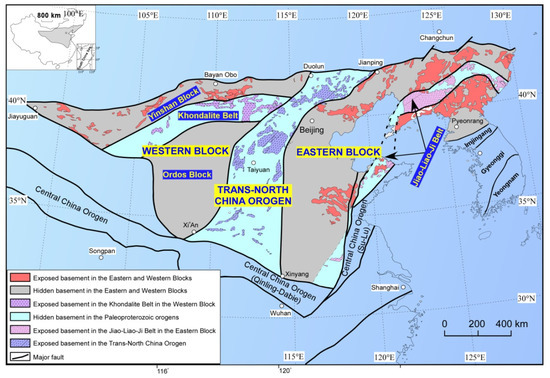
Figure 1.
Tectonic subdivision of the North China Craton proposed by [12,13,29], showing the spatial distribution of basement rocks in the Neoarchean Eastern and Western Blocks, as well as the intervened Paleoproterozoic Trans-North China Orogen.
The discoveries of ancient rocks and zircons can provide evidence for understanding the early evolution of NCC. Early Precambrian rocks are widely distributed in the Eastern Block, wherea ca. 3.8 Ga quartzofeldspathic gneiss complex has been reported in Anshan, Liaoning Province and Lulong, eastern Hebei Province (Figure 2) [7,8,9,10]. The original oldest rock identified was a 3.8 Ga mylonitized trondhjemitic gneiss in the Anshan area [7]. Recently, Wan et al. [10] reported 3.8 Ga granodioritic rocks in the Labashan, Lulong area. For Xinyang, the southern part of the NCC, Ma et al. [30] reported that 3.8 Ga granulite xenoliths were hosted in the Mesozoic volcanic rocks. A large number of 3.8–3.4 Ga detrital zircons have been found in fuchsite quartzite and paragneiss from the Caozhuang area of eastern Hebei Province, indicating that the provenance of these meta-supracrustal rocks mainly consists of Eo- to Paleoarchean igneous rocks [2,31,32,33]. Likewise, abundant ca. 3.8–3.4 Ga detrital zircons have been identified in the fuchsite quartzite in the Lulong area, eastern Hebei Province [34]. However, their provenance and Hf isotopic compositions are poorly constrained. In this paper, we present new geochronological and Hf isotopic data of the ancient detrital zircons from the fuchsite quartzites in Labashan, in the Lulong area, to determine the timing of deposition, the provenance and the regional stratigraphic relationship and further discuss the early crustal growth of the NCC.
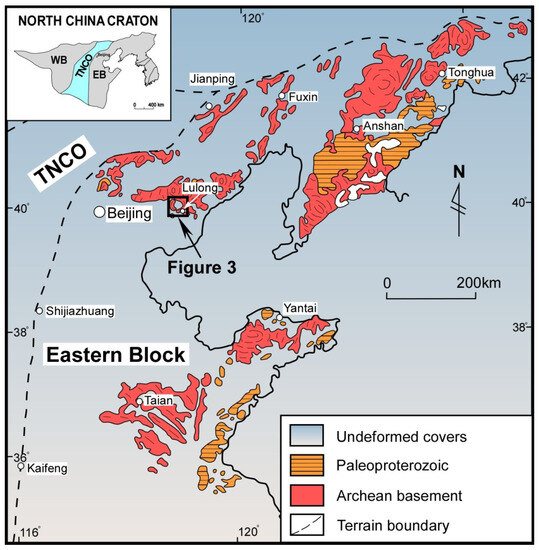
Figure 2.
Geological map of the Eastern Block, showing the distribution of the Archean basements (revised in accordance with [13]).
2. Geological Setting and Sample Collection
The eastern Hebei Province is located in the core of the Eastern Block (Figure 2). The Precambrian terrain in eastern Hebei Province is mainly occupied by Neoarchean rock assemblages which comprise up to 85% of the exposed basement [35,36]. Due to the extensive reworking by later tectonothermal events, the areal extent and the tectonic history of the early Archean basement has been obliterated [37]. The Eoarchean to Mesoarchean rocks only crop out in Caozhuang, Qian’ an and Labashan, Lulong areas (Figure 3) [2,7,31,35]. The Caozhuang supracrustal sequences, which are located in the southwest of the Qian’ an TTG granitic dome, are mainly composed of quartzite, amphibolite, garnet-biotite gneiss, calc–silicate rock, marble, fine-grained biotite gneiss and banded iron formation (Figure 3) [38]. Some scholars proposed that the amphibolites from the Caozhuang area have an age of ca. 3.5 Ga, as determined using the whole rock Sm–Nd isochron method, which may represent the time of the protolithic basalt eruption [39,40,41], although this age may be an inconclusive result [35]. Detrital zircons of 3.8–3.4 Ga have been reported from fuchsite quartzite within the Caozhuang area [2,7,31]. Similar to Caozhuang in the Qian’ an area, Eo- to Paleoarchean materials have also been reported in Labashan in the Lulong area, such as the 3.8 Ga TTG gneisses and 4.0–3.2 Ga detrital zircons in paragneisses (Figure 3) [10,33]. Fuchsite quartzites also developed in Labashan in theLulong area, which are temporally and spatially associated with TTG gneiss, paragneiss, potassium-rich granite and meta-gabbro (Figure 4a). The lithologic features of fuchsite quartzite are similar to those of the Caozhuang area, with a thickness of 5–8 m and an extensional length of more than 100 m (Figure 4b). The fuchsite quartzite, which is composed of quartz (80 vol%) and muscovite (20 vol%) with minor plagioclase and ilmenite (Figure 4c), is intruded by the meta-gabbro (Figure 4d) and is in tectonic contact with the gneisses (Figure 4e).

Figure 3.
Detailed geological map of the Qian’an and Lulong areas, showing the spatial relationshios, lithology and structural features of the Archean supracrustal rock assemblage and granitic pluton.
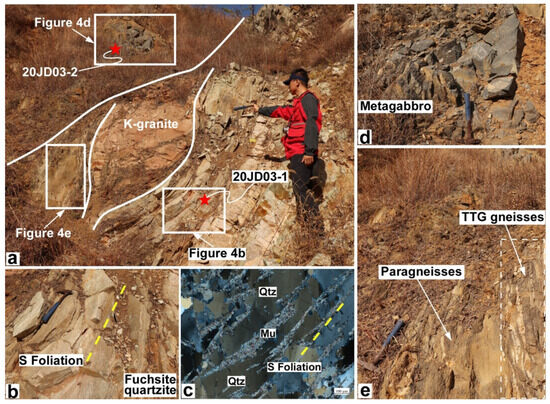
Figure 4.
Representative outcrop and microscopic images of the fuchsite quartzite in the Labashan, Lulong, eastern Hebei Province. (a) The fuchsite quartzite was intruded by the meta-gabbro. (b) Field geological characteristics of the fuchsite quartzite (Sample 20JD03-1). (c) Microscopic images showed mineral composition of the fuchsite quartzite. Abbreviations for different minerals: Qtz—quartz; Mu—muscovite. (d) Field geological characteristics of the meta-gabbro (Sample 20JD03-2). (e) Field geological characteristics of the TTG gneisses and paragneisses.
In this study, two representative samples were collected from Labashan, Lulong to constrain the formation time of the fuchsite quartzite (Figure 4a,b,d). The youngest zircon of Sample 20JD03-1 (fuchsite quartzite) may represent the maximum sedimentation age. In the field, the meta-gabbro dyke clearly intrudes into the fuchsite quartzite (Figure 4a,d); Thus, it can be used to constrain the minimum depositional timing of fuchsite quartzite.
3. Analytical Methods
Zircons were extracted from the samples and separated using conventional heavy liquid and magnetic techniques at the Tuoyan Analytical Technology Co., Ltd., testing center (Guangzhou, China). Representative zircons were hand-picked and mounted onto the epoxy resin surface and then polished to approximately half-thickness. Cathodoluminescence (CL) images of the zircons were acquired using CL spectroscopy on a Quanta 200F SEM (scanning electron microscope) at Nanjing Hongchuang GeoAnalysis, Nanjing, China. The U-Pb analyses of zircons were conducted by laser ablation inductively coupled plasmamass spectrometry (LA-ICP-MS) at the Chengpu Geological Testing Co., Ltd., Langfang, China. The analyses were performed using a Plasma Quant MS elite ICP-MS instrument designed by the Analytik Jena AG (Jena, Germany) in combination with an excimer 193 nm laser ablation system (New Wave, NWR193). Each analysis consisted of a background acquisition of approximately 30s followed by 30s of sample data acquisition. The spot size and frequency of the laser were set to 20 µm and 8 Hz, respectively, in this study. Helium was used as the carrier gas. NIST SRM 610 was applied to yield the highest sensitivity, lowest oxidation, and a stable signal to achieve the optimal condition [42]. A 15 ms dwell time was set for 204Pb, 206Pb, 207Pb, 208Pb, 232Th and 238U. Zircon Plešovice (~337 Ma) [43] and Qinghu (~159 Ma) [44] were used as external standards for U-Pb dating and as the blind sample for monitoring the instrument’s condition, respectively, and were measured twice every 5 zircon analyses. The analytical data were reduced using GLITTER 4.0 software (Macquarie University, Sydney, Australia). The calculation of weighted average ages and plotting of concordia diagrams were completed with Isoplot 4.15 [45].
Zircon Lu–Hf isotopic ratios were determined following U-Pb analyses viaLA-ICP-MS at Chengpu Geological Testing Co., Ltd., Langfang, China. A Neptune Plus (MC-ICP-MS) instrument equipped with a New Wave UP21 LA system at a spot diameter of 44 µm was used with a laser repetition rate of 8 Hz at 6 J/cm2 for 27 s. The detailed analytical procedures and interference corrections used were similar to those described by Wu et al. [46]. The εHf(t) values were calculated based on the chondrite values of 176Hf/177Hf (0.282772) and 176Lu/177Hf (0.0332) ratios [47].
4. Analytical Results
Cathodoluminescence (CL) images of representative zircons from each sample are shown in Figure 5, and zircon U-Pb dating results are shown in Figure 6 and listed in Supplementary Table S1.
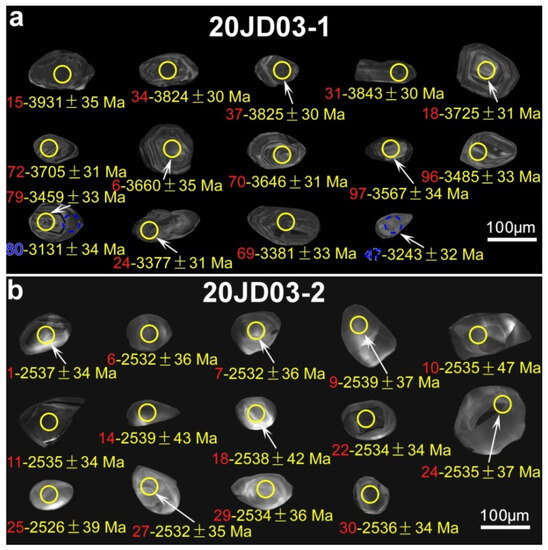
Figure 5.
Representative selection of Cathodoluminescence (CL) images for the selected samples. (a) Sample 20JD03-1: fuchsite quartzite. (b) Sample 20JD03-2: meta-gabbro.
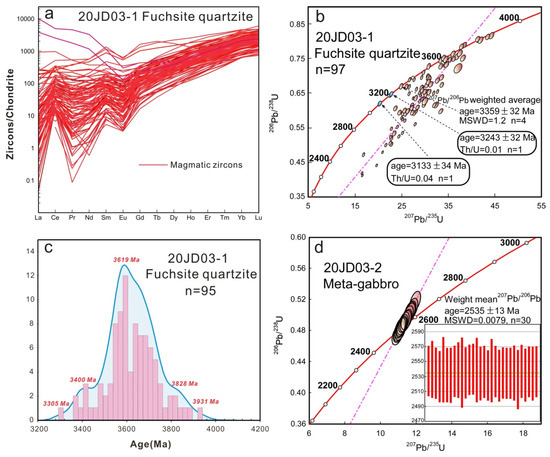
Figure 6.
REE pattern, concordia diagrams and probability distribution of dating zircons. (a) Chondrite-normalized REE pattern for magmatic zircons from the fuchsite quartzite (20JD03-1); (b) U–Pb concordia diagram for zircons from the fuchsite quartzite; (c) Frequency distribution of the zircon age clusters of the detrital zircons from the fuchsite quartzite (20JD03-1); (d) U-Pb concordia diagram for zircons from the meta-gabbro (20JD03-2).
4.1. Zircon LA-ICP-MS U-Pb Dating
4.1.1. Fuchsite Quartzite (20JD03-1)
Sample 20JD03-1 was collected from a fuchsite quartzite in the Labashan, Lulong (Figure 3 and Figure 4a). The fuchsite quartzite exhibits penetrative foliation S at the field and microstructure scales (Figure 4b,c). Zircon grains extracted from the fuchsite quartzite are mostly euhedral–subhedral crystal morphologies and 100–150 μm in grain size (Figure 5a). Most of the zircons exhibit clear oscillatory zoning structure (Figure 5a), indicative of a magmatic origin. Meanwhile, they exhibit enriched LREEs ((Gd/Yb)N = 0.01–1.11), mostly negative Eu anomalies (Eu/Eu* = 0.02–0.34) and moderately to highly positive Ce anomalies (Ce/Ce* = 0.37–216.78), which further confirm a magmatic origin for these zircons (Supplementary Table S2 and Figure 6a). Only one zircon shows thecore–rim structure, where the core (Spot #79) display concentric oscillatory zoning in the CL image (Figure 5a), indicative of a magmatic origin. In contrast, zircon rims (Spot #80 and Spot #47) are relatively luminescent and lack interior structure (Figure 5a), indicative of a metamorphic origin. This is consistent with the relatively low Th/U ratios of 0.01–0.04 (Supplementary Table S1). Ninety-seven zircon grains were analyzed and plotted on the U-Pb concordia diagram (Figure 6b). Of these, two young zircons were assigned the ages of 3133 ± 34 Ma and 3243 ± 32 Ma, respectively, which represented their metamorphic ages (Figure 6b). Most of the zircons fall into the range of 3305 Ma to 3931 Ma and form five distinct age peaks (Figure 6c). The youngest single magmatic zircon age of this sample is ca. 3305 Ma (Figure 6c). The age of the Paleoarchean zircons ranges from 3371 ± 35 Ma to 3796 ± 33 Ma with the most prominent age peak of ca. 3691 Ma and the subordinate age peak of ca. 3400 Ma (Figure 6c). The Eoarchean zircon cluster ranges from 3802 ± 35 Ma to 3882 ± 33 Ma forming a peak at ca. 3828 Ma (Figure 6c). The oldest zircon age in this sample was 3931 ± 35 Ma, with only one single grain (Figure 6c).
4.1.2. Meta-Gabbro (20JD03-2)
Sample 20JD03-2 (meta-gabbro) was collected from the same outcrop as Sample 20JD03-1 (Figure 4a,d). Regionally, the fuchsite quartzite is intruded by the meta-gabbro dyke (Figure 4a). Thus, this gabbro dyke can be used to determine the minimum depositional timing of the fuchsite quartzite. Zircon grains extracted from this sample are transparent and spherical-oval in shape, with a grain size ranging from 100 to 150 μm. CL images reveal that most zircons exhibit blurred oscillatory zoning (Figure 5b), indicating that these zircons could have been influenced by the subsequent anatexis. Th/U ratios for most analyzed zircons are 0.26–4.01 (Supplementary Table S1), which is indicative of a magmatic origin. Thirty zircon grains were analyzed and plotted on the U-Pb concordia diagram (Figure 6d). All the data are concordant and yield a 207Pb/206Pb weighted mean age of 2535 ± 13 Ma (MSWD = 0.0079) (Figure 6d), indicating the crystallization age of the meta-gabbro.
4.2. Zircon Hf Dating
Fifty zircon grains with concordant U–Pb ages from different age populations were analyzed for their Lu–Hf isotopic compositions. The zircon grain with an age of 3305 Ma has an εHf(t) value of −4.2 and a TDM2 model age of 3871 Ma (Supplementary Table S3). The zircon grains with ages in the 3785–3370 Ma range yielded similar compositions (176Hf/177Hf = 0.280253–0.280854, 176Lu/177Hf = 0.000394–0.000872, and 176Yb/177Hf = 0.010547–0.059906) and have εHf(t) values of −9.2 to +8.9, and TDM2 model ages of 3316–4346 Ma (Supplementary Table S3). The zircons of 3862–3802 Ma have similar compositions (176Hf/177Hf = 0.280311–0.280484, 176Lu/177Hf = 0.000425–0.001972, and 176Yb/177Hf = 0.011637–0.059104), and their εHf(t) values and TDM2 model ages are −1.5 to +1.2 and 4034 to 3903 Ma, respectively (Supplementary Table S3). The oldest zircon (3931 Ma) displayed asimilar composition (176Hf/177Hf = 0.280442, 176Lu/177Hf = 0.000889, and 176Yb/177Hf = 0.023647), and it has an εHf(t) value of +4.7, and a TDM2 model age of 3828 Ma (Supplementary Table S3).
5. Discussion
5.1. The Depositional Age of the Fuchsite Quartzite
Detrital zircon geochronology is a widely used method for constraining the depositional age of specific stratigraphic successions [48,49]. Although some geologists proposed that the fuchsite quartzite in the Lulong area was probably deposited after the Mesoarchean (ca. 3.2 Ga) [34], there is currently no confirmed geochronologicalevidence to support this hypothesis.
Given that a sedimentary unit can not be older than its youngest detrital zircon grain [50], our youngest concordant 207Pb/206Pb age group with a weight mean age of 3359 ± 32 Ma, provides a maximum age for the deposition of the fuchsite quartzite in this study (Figure 6b). The meta-gabbro that clearly intruded the fuchsite quartzite yielded an age of 2535 ± 13 Ma, indicating that the fuchsite quartzite must have been deposited sometime earlier than ca. 2535 Ma (Figure 4a,d and Figure 6d). Meanwhile, the metamorphic zircons from the fuchsite quartziteyielded the ages of 3243 ± 32 Ma and 3133 ± 34 Ma, which constrain the metamorphic event (Figure 6b). On the one hand, the ages of the zircon cores are obviously older than 3.1 Ga, indicating that the U–Pb isotopic system of these metamorphic zircons has reached a new equilibrium. On the other hand, the metamorphic zircons have prismatic shape, which can exclude the possibility of metamorphism in source areas [33]. Furthermore, 3.2–3.1 Ga probably represents the record of a tectono-thermal event that occurred after the fuchsite quartzite was deposited. For the same outcrop, Wan et al. [33] also reported the evidence of the Mesoarchean (ca. 3.1 Ga) metamorphic event in the paragneisses (Figure 4a,e). Combining this with the age of the youngest detrital zircon at 3.3 Ga, we can constrain the depositional age of the fuchsite quartzite to be 3.3–3.1 Ga.
Some scholars have proposed that the supracrustal rock assemblage in Labashan, Lulong, is similar to the Caozhuang supracrustal sequence (excluding biotite–granulite and BIF) in Huangbaiyu, Qian’an, with abundant Eoarchean–Paleoarchean zircons (specifically, 3.8 Ga to 3.3 Ga) [33,34]. Additionally, regional stratigraphic correlation indicates that much of the Caozhuang supracrustal sequence is equivalent to the supracrustal rock assemblage in Labashan, Lulong, and also has a depositional age of 3.3–3.1 Ga [33]. To sum up, we defined the whole area as a 3.3–3.1 Ga Caozhuang–Labashan sequence, which is mainly composed of fuchsite quartzite, feldspathic quartzite, biotite plagioclase gneiss, para–amphibolite, ortho–amphibolite and meta–ultramafic rock.
5.2. Determination of Provenance
Determining the source of sedimentary rocks can be achieved through dating of detrital zircon grains [51,52]. In this study, detrital zircons obtained from the fuchsite quartzite sample (20JD03-1) yielded the ages ranging between 3931 and 3305 Ma, which were grouped into five populations (Supplementary Table S1 and Figure 6c). The weighted mean ages of these populations are 3931 Ma, 3828 Ma, 3619 Ma, 3400 Ma and 3305 Ma, respectively (Figure 6c). Most of these ages are consistent with the known tectonothermal events, indicating the potential source information for the fuchsite quartzite.
It is notable that the zircon grains from thefuchsite quartzite exhibit clear oscillatory zoning texture andeuhedral crystal shape (Figure 5a), suggesting no or short distance of sedimentary transportation. Sixzircon grains from the fuchsite quartzite were found to be older than 3800 Ma, with the oldest age of 3931 ± 35 Ma (Supplementary Table S1 and Figure 6c). This is nearly the oldest zircon recorded in the Lulong area. Given that the 3.8 Ga TTG gneiss was reported in the same outcrop of the Labashan area (Figure 4a,e) [10], these zircons were likely derived from this Eoarchean gneiss. The ca. 3.6 Ga, ca. 3.4 Ga and ca. 3.3 Ga detrital zircon grains from the fuchsite quartzite were most likely derived from the Paleoarchean magmatic events in the Caozhuang and Huangbaiyu areas [33,34]. These zircon geochronological data provided valuable information for identifying the Eo- to Paleoarchean rocks in the eastern Hebei Province [33].
5.3. Early Crustal Evolution of the NCC
The high closure temperature of Hf in zircon reduces the influence of later metamorphism or magmatic processes, except for the formation of overgrowths [53]. Therefore, zircon Lu–Hf isotopic data can be used to determine magmatic sources and petrogenetic processes, and to constrain the history of crustal growth [54].
The U-Pb age results of this study provide evidence of the existence of 3.9–3.3 Ga old crustal fragments in the Lulong area, eastern Hebei Province, NCC. Most of the detrital zircon grains of this age display negative εHf(t) values as low as −9.2 (Supplementary Table S3 and Figure 7), while a significant number of zircon grains have positive εHf(t) values as high as +8.9 (Supplementary Table S3 and Figure 7). As shown in Figure 7, the 3305–3524 Ma zircons from the fuchsite quartzite show negative εHf(t) values that are distinct from the positive εHf(t) value of the 3931 Ma. The Hf model ages also suggest that these zircon grains were mainly derived from old recycled basement rocks rather thanjuvenile materials (Supplementary Table S3). Zircon grains with ages between 3540 and 3862 Ma have both positive and negative εHf(t) values (Supplementary Table S3 and Figure 7), indicating that these zircon grains were derived from both recycled old basements and juvenile materials. TDM2 model ages for the 3.9–3.3 Ga zircon grains range from 4.2 to 3.4 Gawith a peak at ca. 3.8 Ga (Supplementary Table S3 and Figure 8), which are significantly older than their U–Pb ages, suggesting that these grains were derived from the reworking of Hadean to Paleoarchean crust. It is worth noting that zircon grains in fuchsite quartzite from the Caozhuang, Qian’ an area show a broadly similar distribution of U–Pb ages spectrum and εHf(t) values (Figure 7). The εHf(t) values of zircons from both fuchsite quartzites decrease regularly with the decreasing ages (Figure 7). Petrologiccharacteristics indicate that the fuchsite quartzite from the Caozhuang area is equivalent to the fuchsite quartzite from the Lulong area.
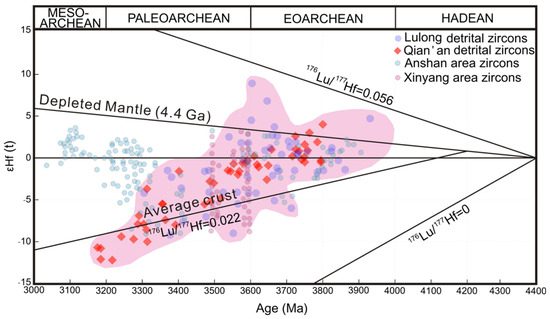
Figure 7.
εHf(t) vs. U–Pb age diagram. The published data of the Qian’an, Anshan and Xinyang are taken from [2,55,56], respectively.
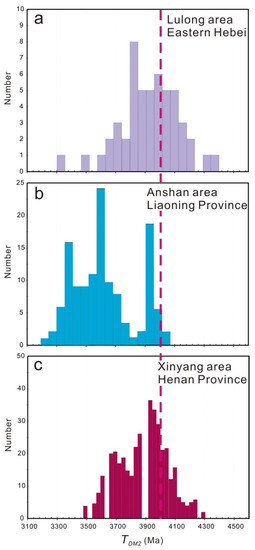
Figure 8.
The comparison of the Hf two-stage model age of the zircons from (a) sample 20JD03-1 (fuchsite quartzite, Lulong area, eastern Hebei Province); (b) Anshan area; and (c) Xinyang area. The Hf isotopic data of the Anshan area and Xinyang area are taken from [55] and [56], respectively.
To address the issues regarding the early crustal evolution of NCC, we compared 3.8–3.0 Ga zircon grains from the Anshan and Xinyang areas (Figure 7). The Anshan area contains the oldest (ca. 3.8 Ga) igneous rocks in the northern NCC [7], as well as abundant ca. 3.45–2.90 Ga granitoids and minor Paleo- to Mesoarchean supracrustal rocks [57,58]. Zircon Hf isotopes indicate that both ancient and juvenile crustal materials contributed to the generation of the Eo- to Mesoarchean zircon grains in the Anshan area (Figure 7) [55]. Their zircon TDM2(t) ages range from 4.0 to 3.2 Ga with a peak at ca. 3.6 Ga (Figure 8b), suggesting significant crustal growth during the Hadean to Paleoarchean [55]. In the southern NCC, the oldest rocks and minerals are the ca. 3.6 Ga felsic granulite xenoliths [59,60] and ca. 3.6 Ga detrital zircons from the Songshan Group [61], respectively. The ca. 3.6 Ga zircons from the Xinyang xenoliths show variable εHf(t) (Figure 7). Zircons with negative εHf(t) values (−2.2 to −8.2) have TDM2(t) model ages of 3.97–4.31 Ga, suggesting ancient crustal components of the Hadean age (Figure 7 and Figure 8c) [56]. Similarly, ca 3.5 Ga zircons in the Xinyang area also show a wide range of εHf(t) (Figure 7). Some of them display negative εHf(t) values of −1.2 to −7.8 and yield TDM2(t) model ages of 3.95–4.12 Ga (Figure 7 and Figure 8c) [56]. This implies that the Hadean crustal materials were involved in the generation of the Paleoarchean felsic magmas. In summary, old (≥4.0 Ga) crustal components have been found in the Eastern Hebei Province (Caozhuang and Lulong areas), Anshan and Xinyang areas. This evidence indicates that the oldest crust in the NCC was formed in the Hadean.
6. Conclusions
- (1)
- Regional correlation reveals that the fuchsite quartzite from the Lulong area is equivalent to that of the Caozhuang area, with a depositional age of 3.3–3.1 Ga constrained by the detrital zircon ages and the metamorphic zircon ages.
- (2)
- The primary sources of sediment in the fuchsite quartzite from the Lulong area were the 3.8 Ga TTG gneisses and the Paleoarchean magmas, specifically those from the ca. 3.6 Ga, 3.4 Ga, and 3.3 Ga.
- (3)
- Zircon Hf model ages from eastern Hebei Province, specifically the Anshan and Xinyang areas, reinforce the theory of the earliest crustal growth event in NCC occurring in Hadean.
Supplementary Materials
The following supporting information can be downloaded at: https://www.mdpi.com/article/10.3390/min13091174/s1, Supplementary Table S1: LA-ICP-MS U–Pb data of zircons for the samples from the Lulong area; Supplementary Table S2: REE concentrations of zircons from the fuchsite quartzite in Lulong area; Supplementary Table S3: Zircon Hf isotopic data of the fuchsite quartzite in the Lulong area.
Author Contributions
Conceptualization, C.Z. (Chen Zhao) and J.Z.; methodology, C.Z. (Chen Zhao) and J.Z.; software, C.Z. (Chen Zhao); validation, J.Z. and C.Z. (Chen Zhao); formal analysis, J.Z.; investigation, C.Z. (Chen Zhao), J.Z., X.W., C.Z. (Chao Zhang), G.C., S.Z. and M.G.; data curation, C.Z. (Chen Zhao) and X.W.; writing—original draft preparation, C.Z. (Chen Zhao); writing—review and editing, J.Z.; project administration, J.Z. and C.Z. (Chao Zhang); funding acquisition, J.Z. and C.Z. (Chao Zhang). All authors have read and agreed to the published version of the manuscript.
Funding
This study was financially supported by the China Geological Survey (DD20230216) and the National Natural Science Foundation of China (42025204 and 42102271).
Institutional Review Board Statement
Not applicable.
Informed Consent Statement
Not applicable.
Data Availability Statement
Not applicable.
Acknowledgments
We sincerely thank three anonymous reviewers for their constructive and helpful comments. We also thank Yazhou Miao and Xiaoman Wang for their assistance in the field.
Conflicts of Interest
The authors declare no conflict of interest.
References
- Smithies, R.H.; Champion, D.C.; Cassidy, K.F. Formation of Earth’s early Archaean continental crust. Precambrian Res. 2003, 127, 89–101. [Google Scholar] [CrossRef]
- Wu, F.Y.; Yang, J.H.; Liu, X.M.; Li, T.S.; Xie, L.W.; Yang, Y.H. Hf isotopes of the 3.8 Ga zircons in eastern Hebei Province, China: Implications for early crustal evolution of the North China Craton. Chin. Sci. Bulletin. 2005, 50, 2473–2480. [Google Scholar] [CrossRef]
- Bowring, S.A.; Williams, I.S. Priscoan (4.00–4.03 Ga) orthogneisses from northwestern Canada. Contrib. Mineral. Petrol. 1999, 134, 3–16. [Google Scholar] [CrossRef]
- Nutman, A.P.; McGregor, V.R.; Friend, C.R.L.; Bennett, V.C.; Kinny, P.D. The Itsaq Gneiss Complex of southern Western Greenland: The world’s most extensive record of early crustal evolution (3900–3600 Ma). Precambrian Res. 1996, 78, 1–39. [Google Scholar] [CrossRef]
- Black, L.P.; William, I.S.; Compston, W. Four zircon ages from one rock: The history of a 3930 Ma-old granulite from Mount Sones, Enderby Land, Antarctica. Contrib. Mineral. Petrol. 1986, 94, 427–437. [Google Scholar] [CrossRef]
- Nutman, A.P.; Kinny, P.D.; Compston, W.; Williams, I.S. SHRIMP U–Pb zircon geochronology of the Narryer Gneiss Complex, Western Australia. Precambrian Res. 1991, 52, 275–300. [Google Scholar] [CrossRef]
- Liu, D.Y.; Nutman, A.P.; Compston, W.; Wu, J.S.; Shen, Q.H. Remnants of ≥3800 Ma crust in the Chinese part of the Sino-Korean Craton. Geology 1992, 20, 339–342. [Google Scholar] [CrossRef]
- Song, B.; Nutman, A.P.; Liu, D.Y.; Wu, J.S. 3800 to 2500 Ma crust in the Anshan area of Liaoning Province, northeastern China. Precambrian Res. 1996, 78, 79–94. [Google Scholar] [CrossRef]
- Wan, Y.S.; Liu, D.Y.; Song, B.; Wu, J.S.; Yang, C.H.; Zhang, Z.Q.; Geng, Y.S. Geological and Nd isotopic compositions of 3.8 Ga meta-quartz dioritic and trondhjemitic rocks from the Anshan area and their geological significance. J. Asian Earth Sci. 2005, 24, 563–575. [Google Scholar] [CrossRef]
- Wan, Y.S.; Xie, H.Q.; Wang, H.C.; Li, P.C.; Chu, H.; Xiao, Z.B.; Dong, C.Y.; Liu, S.J.; Li, Y.; Hao, G.M.; et al. Discovery of ~3.8 Ga TTG rocks in eastern Hebei, North China Craton. Acta Geol. Sin. 2021, 95, 1321–1333, (In Chinese with English Abstract). [Google Scholar]
- Wilde, S.A.; Valley, J.W.; Peck, W.H.; Graham, C.M. Evidence from detrital zircons for the existence of continental crust and oceans on the Earth 4.4 Gyr ago. Nature 2001, 409, 175. [Google Scholar] [CrossRef] [PubMed]
- Zhao, G.C.; Wilde, S.A.; Cawood, P.A.; Sun, M. Archean blocks and their boundaries in the North China Craton: Lithological, geochemical, structural and P-T path constraints and tectonic evolution. Precambrian Res. 2001, 107, 45–73. [Google Scholar] [CrossRef]
- Zhao, G.C.; Sun, M.; Wilde, S.A.; Li, S.Z. Late Archean to Paleoproterozoic evolution of the North China Craton: Key issues revisited. Precambrian Res. 2005, 136, 177–202. [Google Scholar] [CrossRef]
- Yin, C.Q.; Zhao, G.C.; Sun, M.; Xia, X.P.; Wei, C.J.; Zhou, X.W. LA-ICP-MS U-Pb zircon ages of the Qianlishan Complex: Constrains on the evolution of the Khondalite Belt in the Western Block of the North China Craton. Precambrian Res. 2009, 174, 78–94. [Google Scholar] [CrossRef]
- Yin, C.Q.; Zhao, G.C.; Guo, J.H.; Sun, M.; Xia, X.P.; Zhou, X.W. U-Pb and Hf isotopic study of zircons of the Helanshan Complex: Constrains on the evolution of the Khondalite Belt in the Western Block of the North China Craton. Lithos 2011, 122, 25–38. [Google Scholar] [CrossRef]
- Tam, P.Y.; Zhao, G.C.; Zhou, X.W.; Sun, M.; Guo, J.H.; Li, S.Z.; Yin, C.Q.; Wu, M.L.; He, Y.H. Metamorphic P-T path and imphcations of high-pressure politic granulites from the Jiaobei massif in the Jiao-Liao-Ji Belt, North China Craton. Gondwana Res. 2011, 22, 104–117. [Google Scholar] [CrossRef]
- Tam, P.Y.; Zhao, G.C.; Sun, M.; Li, S.Z.; Wu, M.L.; Yin, C.Q. Petrology and metamorphic P-T path of high-pressure mafic granulites from the Jiaobei massif in the Jiao-Liao-Ji Belt, North China Craton. Lithos 2012, 155, 94–109. [Google Scholar] [CrossRef]
- Liu, J.; Zhang, J.; Liu, Z.H.; Yin, C.Q.; Zhao, C.; Li, Z.; Yang, Z.J.; Dou, S.Y. Geochemical and geochronological study on the Paleoproterozoic rock assemblage of the Xiuyan region: New constraints on an integrated rift-and-collision tectonic process involving the evolution of the Jiao-Liao-Ji Belt, North China Craton. Precambrian Res. 2018, 310, 179–197. [Google Scholar] [CrossRef]
- Liu, J.; Zhang, J.; Yin, C.Q.; Cheng, C.Q.; Liu, X.G.; Zhao, C.; Chen, Y.; Wang, X. Synchronous A-type and adakitic granitic magmatism at ca. 2.2 Ga in the Jiao-Liao-Ji belt, North China Craton: Implications for rifting triggered by lithospheric delamination. Precambrian Res. 2020, 342, 105629. [Google Scholar] [CrossRef]
- Liu, J.; Zhang, J.; Liu, Z.H.; Yin, C.Q.; Xu, Z.Y.; Cheng, C.Q.; Zhao, C.; Wang, X. Late Paleoproterozoic crustal thickening of the Jiao-Liao-Ji belt, North China Craton: Insights from ca. 1.95-1.88 Ga syn-collisional adakitic granites. Precambrian Res. 2021, 355, 106120. [Google Scholar] [CrossRef]
- Zhang, J.; Zhao, G.C.; Li, S.Z.; Sun, M.; Liu, S.W.; Wilde, S.A.; Kröner, A.; Yin, C.Q. Deformation history of the Hengshan complex: Implications for the tectonic evolution of the Trans-North China Orogen. J. Struct. Geol. 2007, 29, 933–949. [Google Scholar] [CrossRef]
- Zhang, J.; Zhao, G.C.; Li, S.Z.; Sun, M.; Wilde, S.A.; Liu, S.W.; Yin, C.Q. Polyphase deformation of the Fuping complex, Trans-North china Orogen: Structures, SHRIMP U-Pb zircon ages and tectonic implications. J. Struct. Geol. 2009, 31, 177–193. [Google Scholar] [CrossRef]
- Zhang, J.; Zhao, G.C.; Li, S.Z.; Sun, M.; Chan, L.S.; Shen, W.L. Structural pattern of the Wutai complex and its constraints on the tectonic framework of the Trans-North China Orogen. Precambrian Res. 2012, 222, 212–229. [Google Scholar] [CrossRef]
- Qian, J.H.; Wei, C.J.; Zhou, X.W.; Zhang, Y.H. Metamorphic P-T paths and New Zircon U-Pb age data for garnet-mica schist from the Wutai Group, North China Craton. Precambrian Res. 2013, 233, 282–296. [Google Scholar] [CrossRef]
- Qian, J.H.; Yin, C.Q.; Zhang, J.; Ma, L.; Wang, L.J. High-pressure granulites in the Fuping Complex of the central North China Craton: Metamorphic P-T-t evolution and tectonic implications. J. Asian Earth Sci. 2018, 154, 255–270. [Google Scholar] [CrossRef]
- Qian, J.H.; Yin, C.Q.; Wei, C.J.; Zhang, J. Two phases of Paleoproterozoic metamorphism in the Zhujiafang ductile shear zone of the Hengshan Complex: Insights into the tectonic evolution of the North China Craton. Lithos 2019, 330, 35–54. [Google Scholar] [CrossRef]
- Zhao, C.; Zhang, J.; Liu, J.; Yin, C.Q.; Yang, C.H.; Cui, Y.S.; Peng, Y.B.; Jiang, C.Y. Detrital zircon U–Pb and Hf isotopic study of the Yushulazi Formation in the Gaizhou-Zhuanghe area of the eastern Liaoning: Constraints on the crustal evolution of the North China Craton. Acta Petrol. Sin. 2019, 35, 2407–2432, (In Chinese with English Abstract). [Google Scholar]
- Liu, X.G.; Zhang, J.; Yin, C.Q.; Li, S.Z.; Liu, J.; Qian, J.H.; Zhao, C. A synthetic geochemical and geochronological dataset of the Mesoproterozoic sediments along the southern margin of North China Craton: Unraveling a prolonged peripheral subduction involved in breakup of Supercontinent Columbia. Precambrian Res. 2021, 357, 106154. [Google Scholar] [CrossRef]
- Zhao, G.C.; Wilde, S.A.; Cawood, P.A. Thermal evolution of Archean basement rocks from the eastern part of the North China craton and its bearing on tectonic setting. Int. Geol. Rev. 1998, 40, 706–721. [Google Scholar] [CrossRef]
- Ma, Q.; Xu, Y.G.; Huang, X.L.; Zheng, J.P.; Ping, X.Q.; Xia, X.P. Eoarchean to Paleoproterozoic crustal evolution in the North China Craton: Evidence from U-Pb and Hf-O isotopes of zircons from deep-crustal xenoliths. Geochim. Cosmochim. Acta 2020, 278, 94–109. [Google Scholar] [CrossRef]
- Wilde, S.A.; Valley, J.W.; Kita, N.T.; Cavosie, A.J.; Liu, D.Y. SHRIMP U-Pb and CAMECA 1280 Oxygen isotope results from ancient detrital zircons in the Caozhuang quartzite, eastern Hebei, North China Craton: Evidence for crustal reworking 3.8 Ga ago. Am. J. Sci. 2008, 308, 185–199. [Google Scholar] [CrossRef]
- Wan, Y.S.; Xie, H.Q.; Dong, C.Y.; Kröner, A.; Wilde, S.A.; Bai, W.Q.; Liu, S.J.; Xie, S.W.; Ma, M.Z.; Li, Y. Hadean to Paleoarchean rocks and zircons in China. In Earth’s Oldest Rocks, 2nd ed.; Van Kranendonk, M.J., Smithies, R.H., Bennett, V., Eds.; Elsevier: Amsterdam, The Netherlands, 2019; pp. 294–327. [Google Scholar]
- Wan, Y.S.; Xie, H.Q.; Wang, H.C.; Liu, S.J.; Chu, H.; Xiao, Z.B.; Li, Y.; Hao, G.M.; Li, P.C.; Dong, C.Y. Discovery of early Eoarchean-Hadean zircons in eastern Hebei, North China Craton. Acta Geol. Sin. 2021, 95, 277–291, (In Chinese with English Abstract). [Google Scholar]
- Chu, H.; Wang, H.C.; Rong, G.L.; Chang, Q.S.; Kang, J.L.; Jin, S.; Xiao, Z.B. The geological significance of the rediscovered fuchsite quartzite with abundant Eoarchean detrital zircons in eastern Hebei Province. Chin. Sci. Bull. 2016, 61, 2299–2308. [Google Scholar]
- Nutman, A.P.; Wan, Y.S.; Du, L.L.; Friend, C.R.L.; Dong, C.Y.; Xie, H.Q.; Wang, W.; Sun, H.Y.; Liu, D.Y. Multistage late Neoarchean crustal evolution of the North China Craton, eastern Hebei. Precambrian Res. 2011, 189, 43–65. [Google Scholar] [CrossRef]
- Zhao, G.C.; Zhai, M.G. Lithotectonic elements of Precambrian basement in the North China Craton: Review and tectonic implications. Gondwana Res. 2013, 23, 1207–1240. [Google Scholar] [CrossRef]
- Liu, S.J.; Wan, Y.S.; Sun, H.Y.; Nutman, A.P.; Xie, H.Q.; Dong, C.Y.; Ma, M.Z.; Liu, D.Y.; Jahn, B. Paleo-to Eoarchean crustal evolution in eastern Hebei, North China Craton: New evidence from SHRIMP U-Pb dating and in-situ Hf isotopic study of detrital zircons from paragneisses. J. Asian Earth Sci. 2013, 78, 4–17. [Google Scholar] [CrossRef]
- Zhao, C.; Zhang, J.; Zhao, G.C.; Yin, C.Q.; Chen, G.K.; Liu, J.; Liu, X.G.; Chen, W.L. Kinematics and structural evolution of the Anziling dome-and-keel architecture in east China: Evidence of Neoarchean vertical tectonism in the North China Craton. Geol. Soc. Am. Bull. 2022, 134, 2115–2129. [Google Scholar] [CrossRef]
- Huang, X.; Zi, W.B.; DePaolo, D.J. Sm-Nd isotope study of early Archean rocks, Qianan, Hebei Province, China. Geochim. Cosmochim. Acta 1986, 50, 625–631. [Google Scholar] [CrossRef]
- Jahn, B.M.; Auvray, B.; Cornichet, J.; Bai, Y.L.; Shen, Q.H.; Liu, D.Y. 3.5 Ga old amphibolites from eastern Hebei Province, China: Field occurrence, petrography, Sm-Nd isochron age and REE geochemistry. Precambrian Res. 1987, 34, 311–346. [Google Scholar] [CrossRef]
- Cui, X.H.; Zhai, M.G.; Guo, J.H.; Zhao, L.; Zhu, X.Y.; Wang, H.Z.; Huang, G.Y.; Ge, S.S. Field occurrences and Nd isotopic characteristics of the meta-mafic ultramafic rocks from the Caozhuang Complex, eastern Hebei: Implications for early Archean crustal evolution of the North China Craton. Precambrian Res. 2018, 310, 425–442. [Google Scholar] [CrossRef]
- Pearce, N.J.G.; Perkins, W.T.; Westgate, J.A.; Gorton, M.P.; Jackson, S.E.; Neal, C.R.; Chenery, S.P. A compilation of new and published major and trace element data for NIST SRM 610 and NIST SRM 612 Glass reference materials. Geostand. Geoanal. Res. 1997, 21, 115–144. [Google Scholar] [CrossRef]
- Sláma, J.; Košler, J.; Condon, D.J.; Crowley, J.L.; Gerdes, A.; Hanchar, J.M.; Horstwood, M.S.A.; Morris, G.A.; Nasdala, L.; Norberg, N.; et al. Plesovice Zircon-Anew natural reference material for U-Pb and Hf isotopic microanalysis. Chem. Geol. 2008, 249, 1–35. [Google Scholar] [CrossRef]
- Li, X.H.; Tang, G.Q.; Gong, B.; Yang, Y.H.; Hou, K.J.; Hu, Z.C.; Li, Q.L.; Liu, Y.; Li, W.X. Qinghu Zircon: A working reference for microbeam analysis of U-Pb age and Hf and O isotopes. Chin. Sci. Bull. 2013, 58, 4647–4654, (In Chinese with English Abstract). [Google Scholar] [CrossRef]
- Ludwig, K.R. Isoplot/Ex Version 4.15: A Geochronological Toolkit for Microsoft Excel. Berkeley Geochronol. Cent. Spec. Publ. 2012, 5, 75. [Google Scholar]
- Wu, F.Y.; Yang, Y.H.; Xie, L.W.; Yang, J.H.; Xu, P. Hf isotopic compositions of the standard zircons and baddeleyites used in U-Pb geochronology. Chem. Geol. 2006, 234, 105–126. [Google Scholar] [CrossRef]
- Blichert-Toft, J.; Albarede, F. The Lu-Hf isotope geochemistry of chondrites and the evolution of the mantle-crust system. Earth Planet. Sci. Lett. 1997, 148, 243–258. [Google Scholar] [CrossRef]
- Rainbird, R.H.; Stern, R.A.; Khudoley, A.K.; Kropachev, A.P.; Heaman, L.M.; Sukhorukov, V.I. U-Pb geochronology of Riphean sandstone and gabbro from southeast Siberia and its bearing on the Laurentia-Siberia connection. Earth Planet. Sci. Lett. 1998, 164, 409–420. [Google Scholar] [CrossRef]
- Fedo, C.M.; Sircombe, K.N.; Rainbird, R.H. Detrital zircon analysis of the sedimentary record. Rev. Mineral. Geochem. 2003, 53, 277–303. [Google Scholar] [CrossRef]
- Gehrels, G. Detrital Zircon U-Pb geochronology applied to tectonics. Annu. Rev. Earth Planet. Sci. 2014, 42, 127–149. [Google Scholar] [CrossRef]
- Geslin, J.K.; Link, P.K.; Fanning, C.M. Highprecision provenance determination using detrital-zircon ages and petrography of Quaternary sands on the eastern Snake River Plain, Idaho. Geology 1999, 27, 295–298. [Google Scholar] [CrossRef]
- Cawood, P.A.; Nemchin, A.A. Provenance record of a rift basin: U/Pb ages of detrital zircons from the Perth Basin, Western Australia. Sediment. Geol. 2000, 134, 209–234. [Google Scholar] [CrossRef]
- Kinny, P.D.; Compston, W.; Williams, I.S. A reconnaissance ion–probe study of hafnium isotopes in zircons. Geochim. Cosmochim. Acta 1991, 55, 849–859. [Google Scholar] [CrossRef]
- Wu, F.Y.; Li, X.H.; Zheng, Y.F.; Gao, S. Lu-Hf isotopic systematics and their applications in petrology. Acta Petrol. Sin. 2007, 23, 185–220, (In Chinese with English Abstract). [Google Scholar]
- Wu, F.Y.; Zhang, Y.B.; Yang, J.H.; Xie, L.W.; Yang, Y.H. Zircon U–Pb and Hf isotopic constraints on the Early Archean crustal evolution in Anshan of the North China Craton. Precambrian Res. 2008, 167, 339–362. [Google Scholar] [CrossRef]
- Ping, X.Q.; Zheng, J.P.; Tang, H.Y.; Ma, Q.; Griffin, W.L.; Xiong, Q.; Su, Y.P. Hadean continental crust in the southern North China Craton: Evidence from the Xinyang felsic granulite xenoliths. Precambrian Res. 2018, 307, 155–174. [Google Scholar] [CrossRef]
- Wan, Y.S.; Wu, J.S.; Liu, D.Y.; Zhang, Z.Q.; Song, B. Geochemistry and Nd, Pb isotopic characteristics of 3.3 Ga Chentaigou granite in Anshan area. Acta Geol. Sin. 1997, 18, 382–388, (In Chinese with English Abstract). [Google Scholar]
- Dong, C.Y.; Wan, Y.S.; Xie, H.Q.; Nutman, A.; Xie, S.W.; Liu, S.J.; Ma, M.Z.; Liu, D.Y. The Mesoarchean Tiejiashan-Gongchangling potassic granite in the Anshan Benxi area, North China Craton: Origin by recycling of Paleo- to Eoarchean crust from U-Pb-Nd-Hf-O isotopic studies. Lithos 2017, 290, 116–135. [Google Scholar] [CrossRef]
- Zheng, J.P.; Griffin, W.L.; O′Reilly, S.Y.; Lu, F.X. 3.6 Ga lower crust in central China: New evidence on the assembly of the North China Craton. Geology 2004, 32, 229–232. [Google Scholar] [CrossRef]
- Ping, X.Q.; Zheng, J.P.; Tang, H.Y.; Xiong, Q.; Su, Y.P. Paleoproterozoic multistage evolution of the lower crust beneath the southern North China Craton. Precambrian Res. 2015, 269, 162–182. [Google Scholar] [CrossRef]
- Zhang, H.F.; Wang, J.L.; Zhou, D.W.; Yang, Y.H.; Zhang, G.W.; Santosh, M.; Yu, H.; Zhang, J. Hadean to Neoarchean episodic crustal growth: Detrital zircon records in Paleoproterozoic quartzites from the southern North China Craton. Precambrian Res. 2014, 254, 245–257. [Google Scholar] [CrossRef]
Disclaimer/Publisher’s Note: The statements, opinions and data contained in all publications are solely those of the individual author(s) and contributor(s) and not of MDPI and/or the editor(s). MDPI and/or the editor(s) disclaim responsibility for any injury to people or property resulting from any ideas, methods, instructions or products referred to in the content. |
© 2023 by the authors. Licensee MDPI, Basel, Switzerland. This article is an open access article distributed under the terms and conditions of the Creative Commons Attribution (CC BY) license (https://creativecommons.org/licenses/by/4.0/).